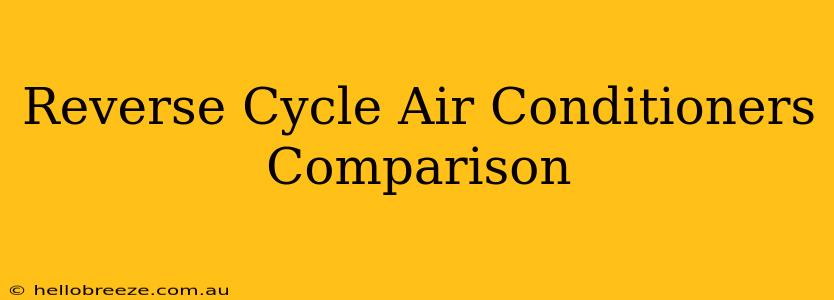Choosing the right reverse cycle air conditioner can feel overwhelming. With so many brands, models, and features available, understanding the key differences is crucial for making an informed decision. This comparison guide will help you navigate the options and find the perfect reverse cycle air conditioner for your home's needs and budget.
Key Features to Compare
When comparing reverse cycle air conditioners, focus on these essential features:
1. Cooling and Heating Capacity (kW):
This is measured in kilowatts (kW) and indicates the unit's power to heat and cool. A higher kW rating means more powerful heating and cooling, suitable for larger spaces. Consider the size of the area you need to climate control when choosing the kW rating. Underestimating can lead to insufficient heating/cooling, while overestimating can be wasteful and costly.
2. Energy Efficiency (SEER/SCOP):
The Seasonal Energy Efficiency Ratio (SEER) for cooling and the Seasonal Coefficient of Performance (SCOP) for heating measure energy efficiency. Higher SEER/SCOP ratings mean lower running costs. Look for units with high SEER/SCOP ratings to save money on your energy bills over the long term.
3. Noise Levels (dB):
Noise levels are measured in decibels (dB). Lower dB ratings mean quieter operation. Consider the location of the unit and your sensitivity to noise when making your choice. Quiet operation is particularly important for bedrooms or living areas.
4. Features and Technology:
Modern reverse cycle air conditioners offer a range of advanced features:
- Inverter Technology: Provides more precise temperature control, leading to greater energy efficiency and quieter operation.
- Wi-Fi Connectivity: Allows you to control your air conditioner remotely using a smartphone app.
- Smart Features: Some models offer learning capabilities, adapting to your usage patterns to optimize energy efficiency.
- Air Purification: Features like HEPA filters remove dust, pollen, and other allergens, improving indoor air quality.
- Zone Control: Allows you to control the temperature in different areas of your home.
5. Installation Requirements:
Consider the installation process and any space requirements. Some units might require specific ductwork or outdoor space for installation. Check if professional installation is included or required and factor in additional costs.
Popular Reverse Cycle Air Conditioner Brands
Several reputable brands offer high-quality reverse cycle air conditioners. Research each brand's reputation, warranty offerings, and customer reviews before making your decision. Some popular brands include:
- Brand A: Known for [mention key features and strengths of Brand A].
- Brand B: Emphasizes [mention key features and strengths of Brand B].
- Brand C: Renowned for [mention key features and strengths of Brand C].
(Note: Replace Brand A, B, and C with actual brand names. This section should be expanded with a more detailed comparison of specific brands.)
Tips for Choosing the Right Unit
- Measure your space accurately: This is vital for determining the correct kW rating.
- Consider your budget: Balance your desired features with your budget.
- Read reviews: Check online reviews to gauge the performance and reliability of different models.
- Seek professional advice: Consult with an HVAC specialist for personalized recommendations.
Choosing a reverse cycle air conditioner is a significant investment. By carefully comparing features, considering your needs, and researching different brands, you can find the perfect unit to provide comfortable and energy-efficient climate control for your home year-round. Remember to always check with qualified professionals for installation and maintenance.

